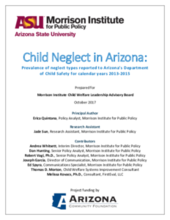Project Objective
The research question that guided this study was: For calendar years 2013-2015, what was the prevalence of different neglect types in Arizona Department of Child Safety (DCS) reports where the most serious allegation was neglect? Further, what were the rates in reports never involving a removal, and reports involving a removal within 30 days of report receipt?
It is a meaningful question to answer because neglect is far more common on the national and local level than physical or sexual abuse, and in many cases can have an equally detrimental impact on children. Although neglect allegations account for 70 percent of all reports made to DCS, the department presently does not have a way to quickly analyze data about different types of neglect occurring. This data is stored in DCS’ data collection system, but system limitations restrict the department’s ability to quickly and easily provide aggregate data in a way that community partners can access and utilize.
There are many ways in which a parent or guardian might neglect a child, but the current reporting practice is to combine all neglect reports under the general term “neglect” without distinguishing the type of neglect. Across the nation, 38 states and the District of Columbia identify medical neglect separately from other types of neglect, but no further distinction is made between other types of neglect. Despite this common practice, neglect can differ significantly.
The objective of this project was to review a sample of reports made to DCS with neglect allegations and identify the types of neglect present in the hotline narrative and investigation narrative. This information is intended to encourage discussion regarding community prevention strategies. Distinguishing types of neglect could result in more targeted prevention strategies aimed at strengthening families and addressing problems before they escalate to the point of DCS involvement. Such an approach, along with state leadership and the Morrison Institute Child Welfare Leadership Advisory Board’s insight and feedback, could go a long way toward improving the outcomes for all Arizona children.

